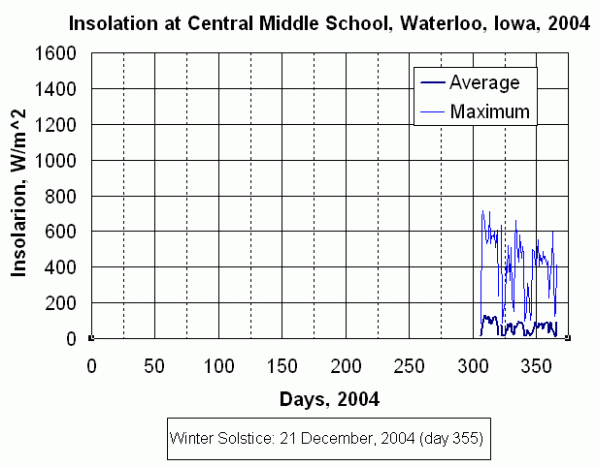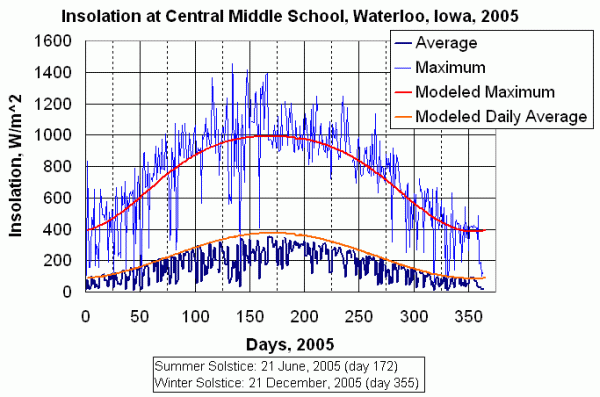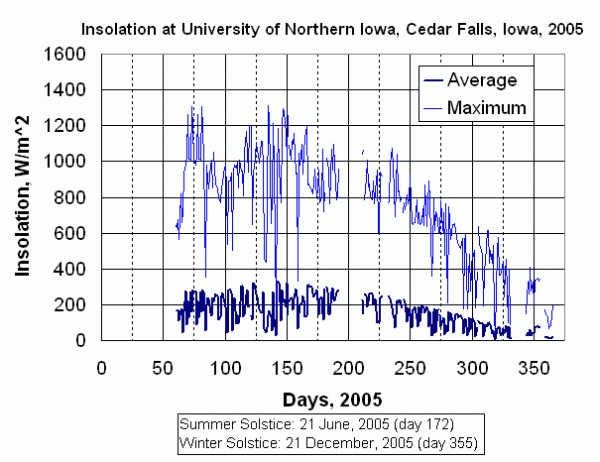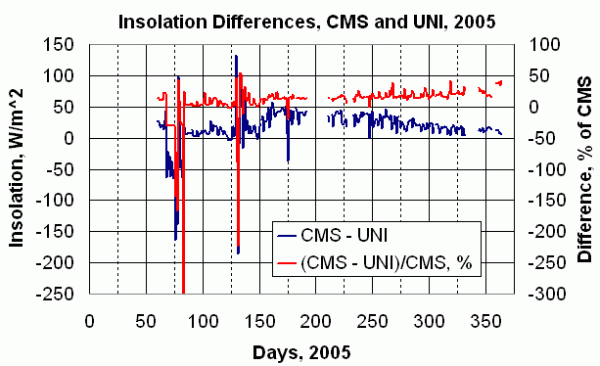


David Brooks, February 2006
Insolation (solar irradiance) data collection started at Central Middle School, Waterloo, Iowa, in September 2004, as part of the GLOBE ONE field campaign. Data collection started at University of Iowa, Cedar Falls, Iowa, in January 2005. The UNI site is roughly 10 km west of the CMI site. Both sites use Apogee pyranometers. The CMS school site uses an older model, PYR, while the UNI site uses a newer PYR-S. The data are sampled and recorded at 1-minute intervals with U12 12-bit data loggers from Onset Computer Corporation. Note that instantaneous values are recorded, rather than sampling at a higher rate and averaging over one minute intervals. (Sometimes more expensive loggers are programmed to do this kind of signal averaging.) Because of the way the U12 loggers digitize small analog signals, "0" nighttime voltages are usually reported as 0.00031 V. This value is too small to have a significant impact on daily averages and has usually been ignored.
The fact that instantaneous, rather than averaged, insolation values are recorded explains spikes in the one-minute data that often exceed the "clear sky" insolation values. This is due to reflection of sunlight from the sides of clouds. These spikes are always accompanied by "negative" spikes when the pyranometer sees the dark sides of clouds. The spikes, which do not represent actual average insolation conditions, are visible in the daily maximum insolation values, but do not have much effect on the daily averages.
The data from the CMS site have always been "clean" and free from obvious problems. Following initial testing and establishing a data reporting protocol during September and October, 2004, there have been only two missing days in the CMS data. In contrast, there are several gaps in the UNI data, resulting from letting the logger run too long between downloads.
The 2005 CMS data are shown along with a simple solar insolation model, described elsewhere on this Web site.
For roughly the first six months, the UNI data often exhibited very noisy signals that were immediately evident at night, when the recorded voltages corresponded to "insolation" values as high as 40 W/m2 or even higher. The source of this noise problem was never found, and eventually (and somewhat mysteriously) disappeared. Unfortunately, a comparative calibration done in Spring 2005, using a third Apogee pyranometer placed side-by-side with each existing instrument for several days, was done during the period when the UNI instrument was experiencing noise problems. As a result, this calibration was not useful.
It was originally hoped that the noise in the UNI data would be truly random and would therefore not greatly affect daily averages of the UNI data. However, the graph of the daily average and maximum insolation demonstrates that this was not consistently true through at least day 150 or so. Therefore, the UNI data need to be treated with suspicion through at least June 2005, when the noise problem appears to have disappeared completely.
 |
 |
 |
Differences between the CMS and UNI daily averages vividly illustrate data problems at the UNI site, assuming that the CMS instrument never exhibited such problems. Between roughly days 90 and 120, the UNI data seem a little high. Large swings in the differences clearly identify serious problems, which may have disappeared by day 160.
 |
The CMS and UNI values show some systematic differences even after June 2005. These differences sometimes exceed 25% of the CMS value. The fact that the percentage differences are smaller in the summer, when the maximum daily solar elevation angle is larger, suggests that there are cosine response differences between the two models of Apogee pyranometers. This is not surprising, as the two versions have some mechanical differences; probably, the UNI instrument has a slightly better cosine resonse. The absolute differences between the two instruments can be minimized by intercalibrations (as was attempted in Spring 2005), and it is even possible to model the average effects of cosine response differences to reduce the daily average differences between the two instruments. For instruments only 10 km apart, it is reasonable to expect that the "real" daily average differences should be very small, especially under clear skies.
An important conclusion to be drawn from examining these data is that the CMS measurements are problem-free and of consistently high quality -- as high as could possibly be obtained with these instruments. Differences between the CMS and UNI data (even after the UNI noise problem was solved) are not fundamentally due to the relatively low cost of the pyranometers (<$150). Differences exist even between very high-quality pyranometers (several thousand dollars). The absolute differences will be smaller, even much smaller, but they will always be due to the same kinds of problems -- imperfect cosine response, noisy signals, etc. -- and they will never completely disappear. Thus this ongoing experiment provides both usable science and a very realistic science experience.